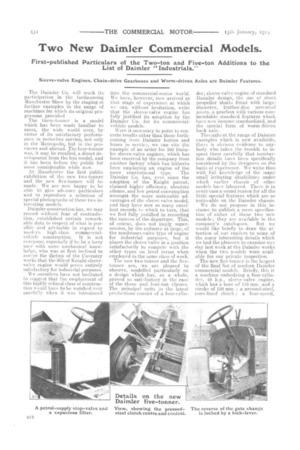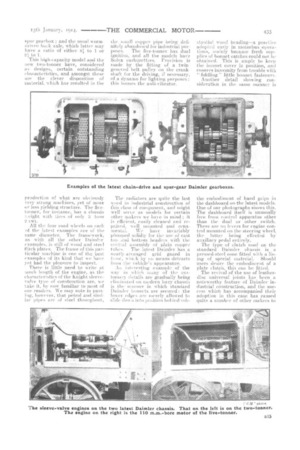Two New Daimler Commercial Models.
Page 6

Page 7

Page 8

If you've noticed an error in this article please click here to report it so we can fix it.
First-published Particulars of the Two-ton and Five-ton Additions to the List of Daimler "Industrials."
Sleeve-valve Engines, Chain-drive Gearboxes and Worm-driven Axles are Daimler Features.
The Daimler Co. will mark its participation in the forthcoming Manchester Show by the staging of further examples in the mange of machines for which its original progranune provided The three-tonner is a model which has been made familiar to users, the wide world over, by virtue of its satisfactory performance in motorbus service, not only in the Metropolis, but in the provinces and abroad. The four-tonner was, it may be recalled, a direct development from the bus model, and it has been before the public for sonic considerable while now.
At Manchester the first public exhibition of the new twotonner and the new five-tormer will he made. We are now happy to he able to give advance particulars and to reproduce a selection of special photographs of these two interesting models.
Daimler construction has, we may record without fear of contradiction, established certain remarkable data io respect of what is possible and advisable in regard to modern high-class commercialvehicle construction. It is not everyone, especially if he be a lorry user with sonic mechanical knowledge, who was at first, inclined to accept the dictum of the Coventry works that the Silent Knight sleeve. valve engine would prove entirely satisfactory for industrial purposes.
We ourselves have not hesitated to suggest that the employment of this highly-refined class of construction would have to be watched very carefully when it was introduced into the commeecial-motor world. We ha ve, however, now arrived at that stage of experience at which we can, without hesitation, write that the sleeve-valve engine has fully justified its adoption by the Daimler Co. for its commercialvehicle models.
Were it necessary to point to concrete results other than those forthcoming from Daimler lorries and buses in service, we can cite the example of an order for 250 Dalinkr sleeve-valve engines, which has been received by the company from another factory which has hitherto been employing an engine of the more conventional type. The Daimler Co. has, ever since the adoption of the Knight patent, claimed higher efficiency, absolute silence, and low petrol consumption amongst the more noticeable advantages of the sleeve valve model, and they have now so many excellent records to which to turn, that we feel fully justified in recording the success of the departure. This, of course, does not imply supersession, by the industry at large, of the mushroom-valve type of engine for industrial purposes, but it places the sleeve valve in a position satisfactorily to compete with the other types on level terms when employed in the same class of work.
The new two-tonner and the fivetonner are, we are pleased to observe, modelled particularly on a design which has, as a whole, proved so satisfactory in the ease of the three and four-ton classes. The principal units in the latest productions consist of a four-cylin der, sleeve-valve engine of standard Daimler design, the Use of short propeller shafts fitted with large diameter, leather-disc universal joints, a gearbox with various commendable standard features which have now become standardized, and the special form of worm-driven back axle.
Throughout the range of Daimler examples which is now available, there is obvious evidence to anybody who takes the trouble to inspect them carefully that numberless details have been specifically considered by the designers on the basis of experience. We write thus with full knowledge of the many small irritating disabilities under which earlier chassis of other models have laboured. There is in every case a sound reason for all the little special features which are so noticeable on the Daimler chassis.
We do not propose in this instance to publish a mere specification of either of these two new models ; they are available in the company's catalogues. But we would like briefly to draw the attention of our readers to some of the many interesting details which we had the pleasure to examine one day last week at the Daimler works when the two models were available for our private inspection.
The new five-tanner is the largest of the final list of modern Daimler commercial models. Briefly, this is a machine embodying a. four-cylinder, 40 h.p., sleeve-valve engine, which has a bore of 110 mm. and a stroke of 150 mm. ; a pressed-steel, cone-lined clutch ; a four-speed, Nair gearbox ; and the usual wormdriven back axle, which latter may have a ratio of either 81 to 1 or (.-,q to 1.
This high-capacity model and the new two-tonner have, -considered as designs, certain outstanding characteristics, and amongst these are the clever disposition of material, which has resulted in the production of what are obviously very strong machines, yet of more or less yielding structure. The fivetanner, for instance, has a chassis weight with tires of only a tons -cwt.
All the four soad -wheels on each of the latest examples are of the same diameter. The framework, as.; with all the other Daimler examples. is still of wood and steel flitch plates. The frame of this particular machine is one of the best examples of its kind that we have yet had the pleasure to inspect.
There is little need to write at inneli length of the engine, as the characteristics of the Knight sleevevalve type of construction are, we take it, by now familiar to most of we readers. We may note in passing, however, that petrol and similar pipes are a steel throughout, the sand] copper pipe being definitely abandoned for industrial pur poses. The five-tonner has dual ignition, and all the models have &ilex carburetters. Provision is made by the fitting of a twingrooved belt pulley on the crankshaft for the driving, if necessary, -of a dynamo for lighting purposes : this houses the anti-vibrator.
The radiators are quite the last NV (1 nd in industrial construction of this elass of component, and might well serve as models for certain other makers we have in mind ; itis efficient, easily -cleaned and repaired. well mounted and ornamental. We have invariably plumped solidly for the use of east top and bottom headers with the central assembly -of plain coppek. tubes. The latest Daimler has a neat la-arranged grid guancl in hoot, whish by no means detracts fstm; the vehicle's appearance.
An interesting example of the Nvay in which many of the customary details are gradually being eliminated on nictiern lorry -chassis is the manner in which standard Daimler bonnets are secured : the lower edges are merely allowed to slide down into position behind sub
stantial wood beading—a practice adopted early in motorbus operations, inainly because fresh supplies of bonnet catches could not he obtained. This is ample to keep the bonnet cover in position, and ensures immunity from trouble with " fiddling "little bonnet, fasteners.
Another detail showing consideration in the same manner is the embodiment of hand grips in the dashboard on the latest models. One -of our photographs shows this The dashboard itself is unusually free from control apparatus other than the dual or other switch. There are no levers for engine control mounted .on the steering wheel, the latter being effected by auxiliary pedal entirely. The type of clutch used on the standard Daimler chassis is a pressed steel cone fitted with a lining of special material. Should users desire the embodiment of a plate clutch, this can be fitted.
The revival of the use of leatherdisc universal joints has been a noteworthy feature of Daimler industrial construction, and the success which has accompanied their adoption in this case has caused quite a number of other makers to
employ them recently. The two new models, of course, embody the latest arrangement of this detail on the short shafts between the clutch and gearbox and the gearbox and back axle respectively ; we illustrate it in detail elsewhere. Light steel covers are now provided; which surround the discs and have the dual function of protecting them from oil and water, arid in the unlikely event of the discs breaking, of holding them together sufficiently for the connection to be uninterrupted.
The chain-drive. gearbox, the evolution of which practically rendered the petrol-driven motorbus a possibility in London traffic, is fitted as standard on Daimler passengercarrying chassis, whether for use as chars-h.-banes or motorbuses. The five-ton lorry and other goodscarrying classes have a well-de signed spur-gear assembly. Both engine and gearbox casings have, cast integral with them, useful oil trays to catch possible overflow or drippings.
The back axle closely follows the lines which have been so successful on London motorbus construction. The pot casting which holds the worm wheel and the differential gear is now registered in the main axle casting, but may be withdrawn from it with facility after the back universal joint is disconnected and the nuts removed front a dozen studs.
All the brakes on both the new machines are on the back wheels ; the drums which are of the same diameter are separately and directly attached to the road wheels. Both brake sets are of the internal-expanding type ; they are of exceptionally large surface and carefully enclosed ; the shoes are now steel lined. The design of these details is especially well calculated to give the minimum of trouble, and should prove very satisfactory in Ii se. A noteworthy modification in connection with the brake installation is the placing of the intermediate brake-banger shaft across the chassis in line with the front spring brackets to which the back springs are anchored. This arrangement, of course, neutralizes the tendency for the brakes to become out of adjustment owing to spring deflection under varying loads. This is a small improvement, but an important. one.
Steel road wheels, of course, are de rigueat throughout, and we have already drawn attention to the practice of fitting equal-sized wheels on both front and back axles. The front axle of the fivetanner is .a particularly fine job ; it is of D. section, and has a reinforced top member to the girder over each stub axle. The springing is well considered on all models, and on these two new machines it is particularly good. Sturdy brackets are employed throughout, and the front springs have a permanent bumping stop bolted over their centres. In .conclusion, we ma.y say a word as to the Daimler method of lubrication—that all-important featuro of all machine construction and design. Spring lubrication has been given specific attention ; one of our illustrations is of this detail, On the smaller of the two new models, all the. pins are lubricated with standard Stauffers ; on the larger machines a very ingenious -form ot oil filler cup is embodied, notably on the spring pins. These latter have an oil cup formed on their outer ends, and the pin itself is drilled and grooved suitably, the entrance to which channel is controlled by a ball valve. A substantial screw cap is provided, which has to be removed when the driver requires to fill the cups with oil.
The same care which ha.s been expended on this little detail is evidenced thyroughout the latest examples of Daimler construction, and we feel confident in predicting for them a foremost position in the industry ; they are already "making good" to a remarkable extent, and notably in Lancashire.




















